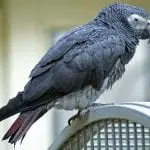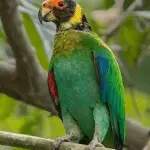Information & Physical Appearance
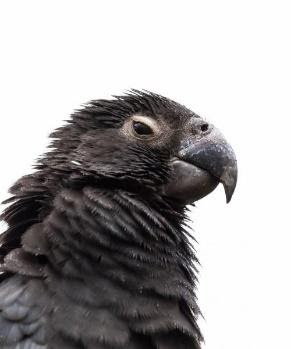
Image Source
The Vasa Parrot (Coracopsis vasa) is classified in the order Psittaciformes, the family Psittacidae, genus Coracopsis.
Other common names include Greater Vasa Parrot, Comoro Vasa Parrot, and Western Vasa Parrot.
There are three to four species recognized up-to-date, as well as several subspecies.
1) Coracopsis vasa – Greater Vasa Parrot
Subspecies of Greater Vasa Parrot
Coracopsis vasa comorensis (Comoro Vasa Parrot)
Coracopsis vasa drouhardi (Western Vasa Parrot)
Coracopsis vasa vasa
Coracopsis vasa vasa adult males display black/grey coloration. More grey is visible on the upper parts of the body.
The undertail coverts are grey, with shafts of feathers exhibiting streaked black coloring.
The primary feathers vary from blue to grey tones. The tail is black/brown while being grey underneath.
The eye ring, as well as the lores, are white/pink in color. Note that the eye ring is only bare. The eye itself is dark brown.
The bill is characterized with horn/pink coloration.
Adult females closely resemble adult males. However, when breeding, females are to lose the feathers on the head zone, revealing their orange/yellow skin as a result.
Adult Western Vasa Parrots are similar in appearance to Coracopsis vasa vasa adults. However, Western Vasa Parrots are paler in color and smaller in size than their counterparts.
Also, there is more grey/blue coloring on the upper parts. Nonetheless, the underside of the tail, as well as the undertail coverts, display grey/white coloration instead of solely grey, as seen in Coracopsis vasa vasa.
Both sexes of Comoro Vasa Parrot adults are paler in color than C.v. vasa. Also, their underparts are only tinged in brown.
Being smaller in size, Comoro Vasa parrots have brown/gray undertail coverts, further characterized with shafts that are darker streaked.
2) Coracopsis nigra – Lesser Vasa Parrot
The Lesser Vasa Parrot is also known as Black Parrot.
Subspecies of Lesser Vasa Parrot
Coracopsis nigra libs
Coracopsis nigra nigra
Coracopsis nigra sibilans (Comoro parrot)
The Comoro Parrot is sometimes considered a separate species.
3) Coracopsis barklyi – Seychelles black parrot
No recognized subspecies.
Lifespan
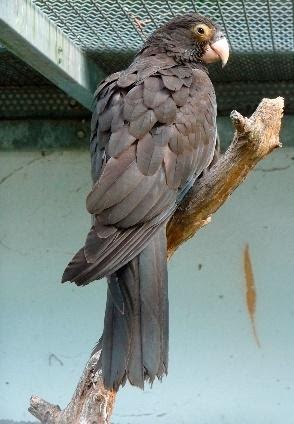
Even though solid evidence regarding the lifespan and longevity of Vasa Parrots in the wild still lacks up-to-date, there is a recorded case of a Vasa Parrot individual reaching 53.9 years of age in captivity.
The generation length is estimated at 13.8 years.
Ecosystem & Habitat
Video URL: https://www.youtube.com/watch?v=mHyNq6ylnG0
RANGE
The three species of vasa parrots (Coracopsis) are endemic to Madagascar, as well as to several other islands located in the western Indian Ocean. These parrots are residents within their range.
C.v. vasa are found in eastern Madagascar.
C.v. drouhardi occurs in Western Madagascar.
C.v. comorensis is native to Anjouan, Moheli, and the Comoro Islands.
HABITAT
Vasa parrots are known to inhabit a wide variety of habitats, ranging from dry, open savanna and woodland to dense, moist forests. They are found at elevations of up to 3280ft. (1000 meters).
Also, these parrots inhabit cultivated areas.
Food & Diet
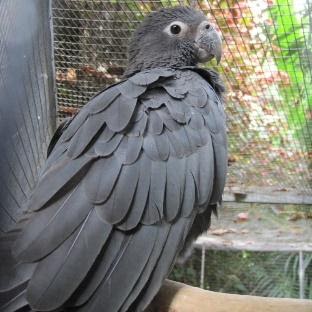
Image Source
Vasa Parrots’ wild diet consists of nuts, berries, seeds, and fruits. These parrots also feed on cultivated millet, maize, and rice, and are therefore sometimes regarded as crop pests.
Behavior
When feeding, as well as when roosting, vasa parrots will commonly congregate in larger flocks, forming quite noisy parties.
It is in the tops of tall trees where these birds roost. At least one individual is to remain awake, perched on the top of large trees, perfectly able to stay on the lookout of possible danger, and warn the others promptly as necessary.
Reproduction
Although not much is known when it comes to the breeding season for Vasa parrots, it is believed to most probably take place in October, continuing up until December.
Vasa parrots build their nests in the cavities of the tree, or in a tree trunk. Adansonia trees (baobab trees) are highly preferred for nesting in the western portion of Madagascar.
Sometimes, several nests are built in the very same tree.
Breeding males are known to become especially territorial and rather aggressive when defending their breeding grounds.
The young are completely devoid of markers upon being born, with legs that are way too long for the average parrot.
Survival Threats & Conservation
Vasa Parrots are listed on CITES’ Appendix II.
Also, they are classified under the Least Concern category on the IUCN Red List of Threatened Species.
The number of mature individuals in the wild remains unknown, and there is an absence of a systematic monitoring scheme.
The population trend is decreasing, and there is no action recovery plan set up-to-date. Fortunately, the population is not severely fragmented.
Furthermore, conservation sites are identified over the entire range.
The major threats to the future survival of the species include Vasa Parrots being hunted for food, trapped for wild bird trade, and, nonetheless, being officially treated as a harmful bird species because of causing extensive damage to crops, such as maize and rice.
Not the least, habitat loss does also threaten the future of Vasa Parrots in the wild, and it is still hard to clearly estimate the possible negative consequences of climate change.
Availability – Where to Get a Vasa Parrot
Video URL: https://www.youtube.com/watch?v=_MSOVwaTDW4
Note that Vasa parrots are extremely rare in captivity. It is quite difficult to find a Vasa parrot available for sale in aviaries, and this is believed to be related to the initial lack of spectacular, striking coloration, which is typical for other species of parrots.
For those who are eagerly determined to acquire a vasa parrot pet, make sure to receive a guarantee of the bird’s captive-bred status, as not to stimulate the illegal trapping of vasa parrots in the wild.
Interesting Facts
1. The Vasa parrot is considered sympatric with Coracopsis nigra (the Black parrot), to a very large extent.
However, vasa parrots are somewhat paler in color when compared with black parrots, as they display more greyish brown tones rather than dark brown as seen in their counterparts. Also, vasa parrots are larger in size.
2. Despite being diurnal creatures, it is thought that Vasa Parrots actually become most active in full moonlights.
3. During the breeding season, the skin of both male and female vasas is to turn yellow, usually accompanied by loss of feathers.
Feather loss during the breeding season can actually result in females becoming completely bald.
4. Another curious feature of the breeding physiology of female vasa parrots is the way the black to grey feathers turn brown without a molt.
The way breeding females’ feathers can change color without a molt is explained by the redistribution of melanin. It is the melanin pigment to make vasa parrots’ feather black in color.
5. Vasa parrots are notable species in the parrot world. Their appearance is quite peculiar. Some of the features to set vasas apart from other parrots include the pink-colored beak, the grey/black feathers, and nonetheless, the extremely short body, as compared with the noticeably long necks.
6. Apart from the unusual appearance that makes Vasa Parrots unique amongst other parrot species, there are certain aspects of their physiology to further contribute to their uniqueness.
Vasa parrot chicks are to hatch after only about 20 days of incubation. Their rather short incubation period is highly irregular since other similarly sized parrots are known to take up to a month to hatch!
7. Baby vasas are “equipped” with pads on their beaks. When these pads are stimulated promptly, they serve the important function of triggering a strong feeding response.
After only a few weeks, these unusual pads are to disappear, though. Regardless, the “weaning” reflex, commonly referred to as a “feeding” reflex, is about to stay unusually strong until well into vasas’ adulthood.
It is often the case that aviculturalists will need to make use of a syringe in order to force-feed young vasa parrots since the high intensity of their weaning reflex prevents the chicks from being hand-fed with a spoon successfully.
8. It was during the 1970s when the first big wave of Vasa parrots was exported into America and Europe. Many of the exported-imported individuals got infected with a psittacine disease which affects both the beak and the feathers.
The psittacine disease infected vasa parrots were not really recognized as sick but instead, they were advertised as rare albinos by importers.
9. It was in 2011 when a genetic study found that Réunion’s Mascarene parrot
is to be nested among lesser vasa parrots’ subspecies, in particular, the subspecies of lesser vasa parrots found in Madagascar and some of the nearby islands.
Therefore, the Mascarene parrot was not considered to be related to Psittacula parrots at all. Mascarene parrots’ line was discovered to have diverged some 4.6 to 9 million years ago, which happened before the Reunion was formed. This discovery indicated that the divergence of Mascarene Parrots must have occurred elsewhere.
Later on, another group of scientists acknowledged the finding, yet highlighted that the very sample might have been damaged. This resulted in further testing for the purpose of resolving the mysterious issue of origin.
Ultimately, experts found anatomical similarities between the Mascarene parrot and psittaculines like the Vasa parrot, among others, from the islands. Unfortunately, the Mascarene parrot (Mascarinus mascarinus) is now already extinct.
How to Care for the Vasa Parrot
1. Personality
Out of the rather limited information available on how to care for the Vasa parrot as a pet, this bird species is reported as an extremely cunning, highly intelligent creature.
Although “equipped” with strong beaks, their beaks are not as strong as to destroy hardwood.
During the breeding season, Vasa parrots tend to become very noisy, and nonetheless, very territorial, up to the point of exhibiting aggressive behavior.
2. Housing
Vasa parrots should be housed in a walk-in-aviary, which measures at least 23ft. (7 meters) in length.
3. Diet
In captivity, their diet consists of about 30% fruits, such as pomegranate, oranges, pears, and bananas, among others, as well as vegetables, such as green peas, celery, green leaves, fresh corn, and carrots.
Spray millet and limited mixed seeds make up for the majority of a balanced diet in captivity. Complete kibble has to be provided.
Vasa Parrots will gladly consume walnuts, among other nuts.
FAQ Section
What Do Vasa Parrots Eat?
In the wild, Vasa Parrots are known to eat a variety of seeds, nuts, berries, and fruits. In captivity, a healthy, balanced diet should consist of limited seed mix and spray millet, and about 30% of fresh vegetables and fruits.
How Big Do Vasa Parrots Get?
Both adult male and female Vasa Parrots get as big as about 50cm (19.5 inches) in length, with some of the subspecies being slightly smaller in size. On average, Vasa parrots weigh up to 480 grams (16.8 oz.).
Are Vasa Parrots Endangered with Extinction?
Based on the results of the 2018 global assessment, Vasa Parrots are not considered critically endangered with extinction. However, they are listed as Least Concern on the IUCN Red List of Threatened Species and are subjected to international trade controls.
How Do You Take Care of a Vasa Parrot?
Taking care of a vasa parrot as a pet may be a challenging task for the newbies since these feathery fellows are not commonly raised in captivity. While there is not much information when it comes to taking the best care of these amazing creatures, some of the basic requirements include providing a spacious enclosure, plenty of social interaction, and a balanced, varied diet.
Are Vasa Parrots Loud?
Yes, Vasa Parrots can be very loud and noisy, and especially during the breeding season. They are also capable of learning how to mimic human speech.

